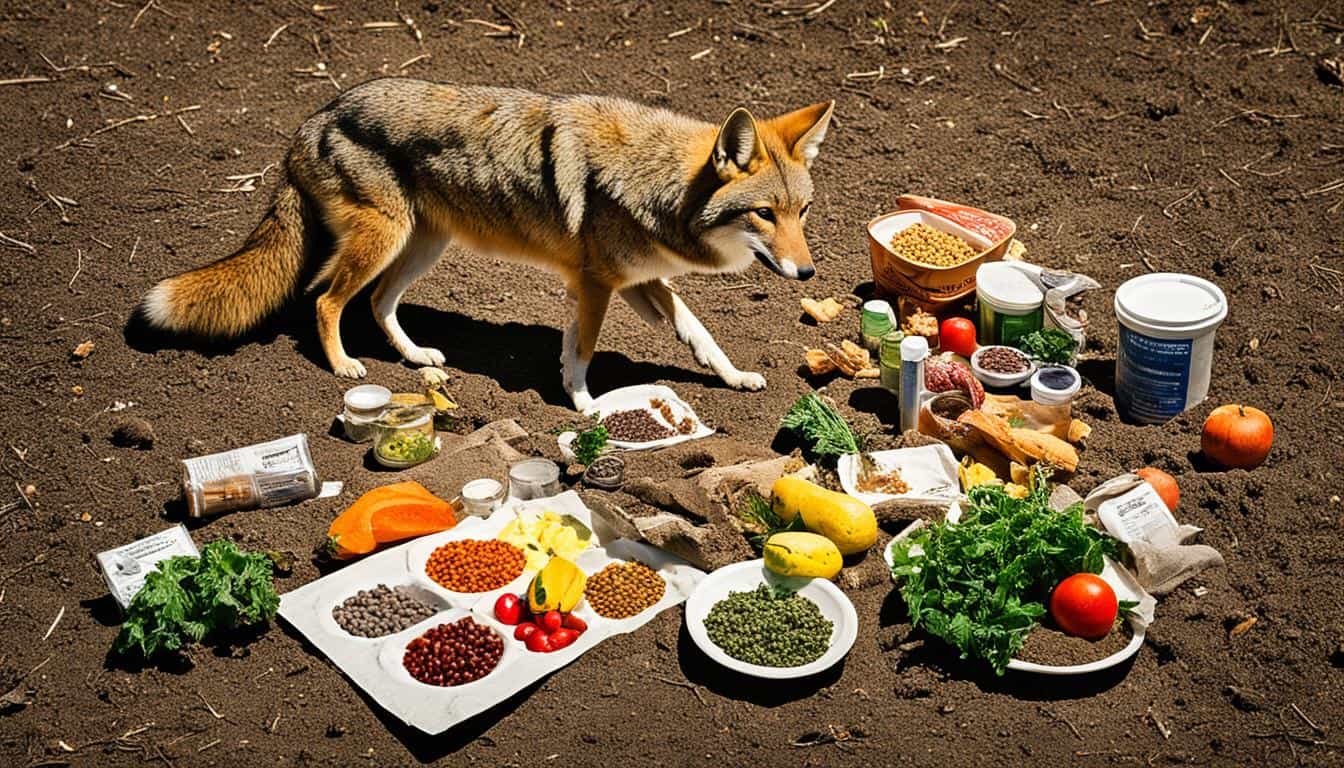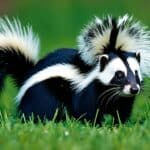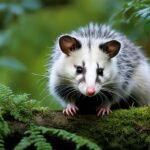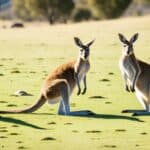Have you ever wondered what the elusive coyote eats? It survives in places like the Sonoran Desert and busy cities. How does it do this?
The coyote, or Canis latrans, is super adaptable. It lives in many places, even with humans around. In Maine, there are about 12,000 coyotes. Learning about their diet helps us see why they do so well.
Coyotes eat a lot of things, making them opportunistic omnivores. They hunt small animals like rodents and birds. They also eat carrion, like dead animals, and fruits in summer and fall. When near humans, they might eat pet food or garbage.
In winter, coyotes hunt larger animals, such as deer. They do this because deer are slower in the snow. This shows how clever and flexible coyotes are in finding food.
Coyote’s General Dietary Habits
Coyotes are known for being able to eat almost anything, from plants to animals. This wide range of diets lets them live in many places, like deserts and cities. They change what they eat based on the time of year and what food is around. This helps them survive no matter where they are.
Omnivorous Nature
The omnivorous coyote diet means they eat both plants and animals. For example, they may eat rodents, rabbits, and insects. They also enjoy fruits and vegetables. This mix of foods is key to their success in different places and at different times. In places like the Sonoran Desert, they eat cactus fruits and mesquite beans when these are available.
Seasonal Variations in Diet
Coyotes change what they eat as the seasons do, and this is an important strategy for surviving. Their seasonal coyote diet matches what foods are easiest to find. In the winter, they might eat more deer because the snow slows them down. But in the summer, they go for fruits, insects, and smaller animals. This shows their smart and changing coyote feeding patterns.
Coyote Prey Animals
Coyotes eat many types of food, which helps keep nature balanced. This includes a variety of prey animals, each important for the coyote’s diet. We will look at what kind of prey they eat and why it matters for their health.
Small Mammals: Rodents, Hares, Beavers
Small mammals are key to a coyote’s nutrition. Coyotes target rodents like mice and rats a lot. For small mammal diet, these are a big part. They also go after snowshoe hares and woodchucks. In certain areas, beavers are on their menu. This diet gives coyotes what they need to stay healthy and strong.
Birds, Reptiles, and Amphibians
Coyote prey includes birds, reptiles, and amphibians too. This mix makes them able to live in many places and get all their nutrients. They often hunt birds that nest on the ground, sometimes eating their eggs. And when they can, they also eat things like frogs, snakes, and lizards. This wide diet is part of what makes them such successful animals.
| Prey Category | Examples | Nutritional Contribution |
|---|---|---|
| Small Mammals | Rodents, Hares, Beavers | High in protein and essential nutrients for coyote nutrition |
| Birds | Ground-nesting birds, eggs | Provides protein and fats |
| Reptiles and Amphibians | Frogs, Lizards, Snakes | Rich in proteins, vitamins, and minerals |
Coyote Hunting Behavior
Coyotes have a wide range of hunting styles. They change their methods based on what they’re hunting. This can be anything from small to large animals. By being both solitary and working with others, coyotes are highly effective at finding food. This helps them survive in many different places.
Solo Hunting Techniques for Small Prey
Hunting small prey like mice, rabbits, and some birds, coyotes do it alone. They use skills like walking silently and then jumping on their prey. This catches their meal off guard. Coyotes use their amazing hearing and smell to find the little creatures. When they do, they move quickly to take them down.
Cooperative Hunting for Larger Prey
When going after bigger food, like deer, coyotes team up. They use a strategy where some coyotes chase the deer in turns. The others wait ahead to cut the deer off. This teamwork shows how they are great at working together. It also makes their hunts more likely to get the big prey.
Scavenging Habits of Coyotes
Coyotes are incredible at adapting. They eat many things, including roadkill and farm animal carcasses. This skill helps them survive in places without much natural food, like cities and suburbs.
They’re not scared to find food near people. Coyotes use any chance to eat, especially from dead animals. This ability to eat different things helps them live in different places, showing how important it is for them to survive.
Plant-Based Diet Components
Coyotes are omnivorous, eating both meat and plants. They add a lot of plant foods to their meals. This mix helps them do well in different places, especially when finding meat is hard.
Fruits and Berries
In the warmer months, you might see coyotes enjoying fruits and berries. These foods are everywhere and packed with good stuff. Wild grapes and blackberries are favorites for the plant part of a coyote’s diet.
Grass and Garden Crops
Grasses and crops from gardens are also key to a coyote’s diet. It’s common to see them in gardens eating up. They show that they can live well in cities and towns, taking what’s easy to find in gardens.
Variation in Diet by Region
When looking at the diet of regional coyotes, we see differences. These differences are between Western and Eastern coyotes. They are also different in urban versus rural places.
Western vs. Eastern Coyotes
Western and Eastern coyotes eat in very different ways. Western coyotes eat mainly small mammals and reptiles. These foods are found in dry areas. On the other hand, Eastern coyotes are normally bigger. They often eat deer and other big animals because their area is larger.
Urban vs. Rural Environments
Coyotes in cities have very different diets from those in the countryside. In cities, coyotes eat foods that humans leave out. This includes garbage, pet food, and leftovers from restaurants. But in rural places, they mainly eat natural foods. They catch a lot of small mammals, birds, and sometimes even animals like sheep. This shows how clever and adaptable coyotes can be.

| Region | Common Prey | Urban vs. Rural |
|---|---|---|
| Western Coyotes | Small mammals, reptiles | Predominantly natural prey in both urban and rural areas, with occasional scavenging in urban zones |
| Eastern Coyotes | Deer, larger mammals | Human-associated foods in urban areas; natural prey and larger mammals in rural areas |
Impact of Human Activity on Coyote Diet
Human activity has changed what coyotes eat in big ways. These smart animals now find new foods in cities and towns. This changes what they used to eat.
Influence of Pet Food and Garbage
Coyotes eat pet food that’s outside, which is known as coyote consumption of pet food. They can also find scraps in trash bins. This makes them lose their fear of humans. So, we might see them more often.
Interaction with Livestock and Poultry
Coyotes can also hunt farm animals like chickens, goats, and sheep. This is tough for farmers. They want to protect their animals but also keep local wildlife safe.
What is the Diet of a Coyote During Winter?
In winter, the diet of coyotes changes a lot. The cold weather makes them find food in new ways. The main parts of a winter coyote diet are more scavenging and clever hunting in snow.
Increased Scavenging
Winter’s cold cuts down on the food coyotes can catch. So, they start looking for food in other ways. This includes eating carrion, old food, and leftovers of other animals. This not only helps them survive but also keeps nature clean by eating dead things.
Hunting in Snowy Conditions
When it snows, coyotes find new ways to hunt. The snow and cold slow down big animals like deer. This makes them easier to catch. Coyotes work together and use their smarts to catch these animals. It shows how well they can live in hard winter times.
By doing both more scavenging and hunting, coyotes show they’re great at dealing with tough times of the year.
Feeding Patterns Throughout the Year
Coyotes change their eating habits with the seasons, which shows how adaptable and clever they are. To understand how they survive all year, it’s key to look at their feeding patterns.
Spring and Summer Diet
In spring and summer, coyotes eat a lot of different foods. This time, they eat more small animals, bugs, and fruits. The warm weather makes it easier for them to find food like berries.
Since small animals are out more, coyotes hunt them. They also pick berries from plants. Their diet changes a lot to use whatever is around.
Autumn and Winter Diet
When it’s fall, coyotes get ready for winter by changing how they eat. They look for bigger animals like deer since those are easier to catch now. With winter’s cold and less food, they also scavenge more.
As winter sets in, coyotes adapt their hunting. They focus on prey that’s slower in the snow. This shows how they adjust their diets and hunting to survive all year long.
FAQ
What is the diet of a coyote?
Coyotes eat a mix of small animals and plants. They like rodents, hares, beavers, birds, and reptiles. They also eat plants like fruits and berries.
During summer and fall, they might eat what they find in gardens. This includes pet food, garbage, and even livestock and poultry.
What are the general dietary habits of coyotes?
Coyotes eat a bit of everything, showing they can be flexible. They eat animal prey and plants, changing with the seasons and where they live.
How does the diet of coyotes change seasonally?
In spring and summer, they eat more small mammals, bugs, and plants. By fall and winter, they go for bigger animals like deer. They also scavenge more in the colder months.
What kinds of small mammals do coyotes eat?
Coyotes often eat small mammals like rodents, hares, and beavers. These acts as pest control in many ecosystems.
Do coyotes eat birds, reptiles, and amphibians?
Yes, they do. Coyotes will hunt birds, reptiles, and amphibians opportunistically. This adds to their diverse diet.
What hunting techniques do coyotes use for small prey?
For small game, they usually hunt alone. They stalk then pounce on their dinner. This shows how skilled and smart they are.
How do coyotes hunt larger prey like deer?
When it comes to bigger animals like deer, coyotes often hunt in groups. They use teamwork and strategy to capture their prey.
What are the scavenging habits of coyotes?
They are very good at scavenging. Coyotes eat a lot of carrion, like roadkill and dead farm animals. This helps a lot, especially in areas with more people.
What plant-based foods do coyotes consume?
In the summer and fall, they enjoy fruits and berries. They also nibble on grass and veggies they find, even in gardens.
How does the diet of coyotes vary by region?
Different areas have different food for coyotes. Eastern and Western coyotes have different diets. Urban coyotes eat more human food than those in rural areas.
How does human activity influence the diet of coyotes?
Humans change what coyotes eat. They find food like pet food and garbage. This makes them used to people and can lead to problems. Sometimes they even eat farm animals.
What do coyotes eat during winter?
In winter, coyotes scavenge more. They might eat deer that are sick or weak. Snow makes deer slower and easier to catch.
How do coyote feeding patterns change throughout the year?
Feeding habits change as the seasons do. Spring and summer bring lots of small animals and plants. As it gets colder, they focus on big prey and more scavenging.







